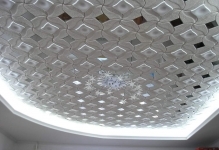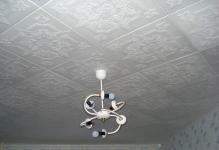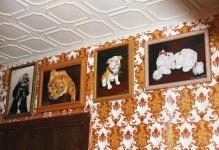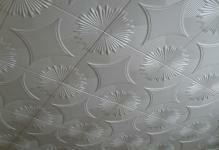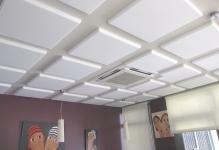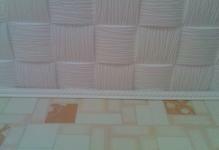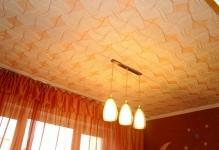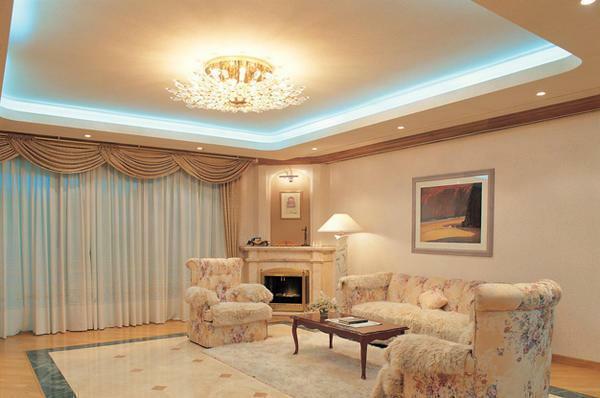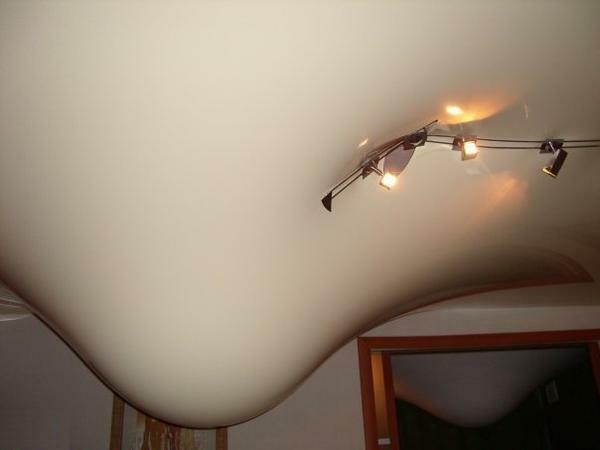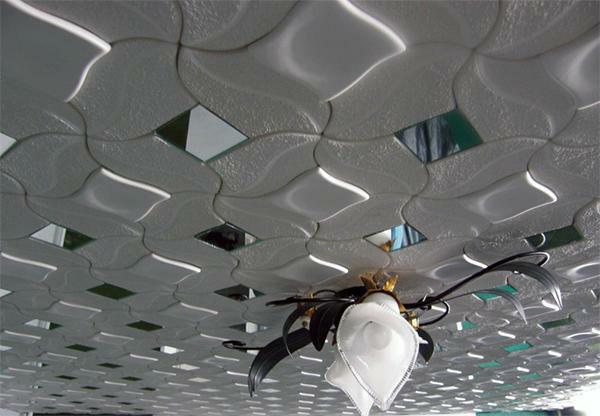 Foamed ceiling tiles perfectly match with various interior elements Foam is an easy cheap and very useful material for home. If you want to quickly and inexpensively make the finish of the ceiling, then be sure to consider the option with polystyrene foam. If you make the right pasting, as well as choose the right material, the result can please you for more than a decade!Meet the varieties of foam plates and the functional features of each species.
Foamed ceiling tiles perfectly match with various interior elements Foam is an easy cheap and very useful material for home. If you want to quickly and inexpensively make the finish of the ceiling, then be sure to consider the option with polystyrene foam. If you make the right pasting, as well as choose the right material, the result can please you for more than a decade!Meet the varieties of foam plates and the functional features of each species.
-
- Types slabs of expanded polystyrene ceiling
- Finish ceiling foam tiles: the pros and solutions
- cons How to glue the ceiling tiles from foam
- ceiling of foam slabs: operation features
- Laying foam tilesOn the ceiling( video)
- Foam ceiling tile( photo)
Styrofoam types for the
ceiling Despite the popular belief that the foam is only oneIn reality, there are as many as 3 types of foam that differ in many ways. Therefore it is important to know what each of them represents.
Foam plates according to the type of production are of three types:
- Stamped plate. This kind is done with the help of a press, stamping out of blocks of construction polystyrene foam. The stamped plate is the cheapest in relation to other types of plates, it is easily glued to the ceiling, it can be painted with water-dispersion paints. Despite all these advantages, this species also has disadvantages: on the perimeter of such plates there is a cant, because of which each plate is allocated on the ceiling. But, perhaps, the most important disadvantage is the fragility of such a plate.
- Injection plate. Such a tile is thicker than stamped. It is made from high quality raw materials, baking in molds. Also, its thickness makes it possible to put a deep relief pattern, and the edging during installation is almost not noticeable, thanks to which the ceiling looks whole. The material of this plate is self-extinguishing during arson, therefore it is safe in case of fire.
- Extruded plate. It is produced by extrusion of polystyrene and has a greyish-white hue. This plate is the strongest, although it is as thin as the stamped plate. Its disadvantage is a rather high price, as well as the fact that the dimensions of the product are not accurate enough, and when installing, gaps are obtained.
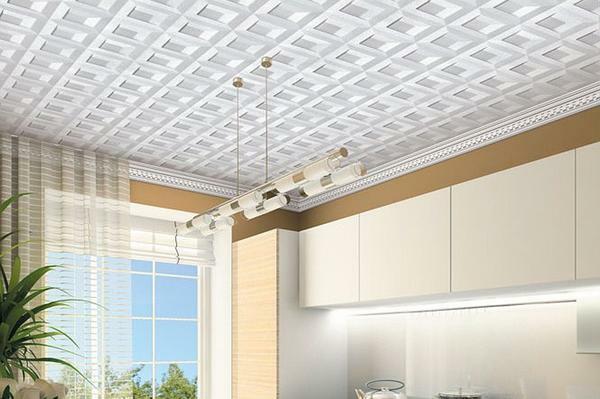 Fire safety and sound insulation are the main advantages of The three types of the most optimal option for the ratio of price and quality is the injection. Therefore, if you want a durable beautiful tile, choose this kind.
Fire safety and sound insulation are the main advantages of The three types of the most optimal option for the ratio of price and quality is the injection. Therefore, if you want a durable beautiful tile, choose this kind.
Finishing the ceiling with foam tiles: the pros and cons of the solution
If you decide to use this material for finishing your ceiling, it is recommended to get acquainted with the advantages and disadvantages that this material has.
The disadvantages of polystyrene foam include the following:
- No indicators for the environmental friendliness of the material. The foam does not breathe, it is completely made from non-natural materials, so it is necessary to provide a decent ventilation system for proper air circulation.
- Plates are melted under the influence of high temperatures, so there are restrictions on the location of foam materials.
- Not shockproof. If there is a risk of hitting sharp or cutting objects on the ceiling, it is better to refrain from foam on the ceiling.
- Unpresentable. If you do not take too much work on the choice of quality and original plates, the result may not be very attractive: noticeable seams, crumbling edges, unevenness and other troubles will spoil the overall feeling of the room. Therefore, carefully look at the quality of the material and the pattern on the proposed foam plates.
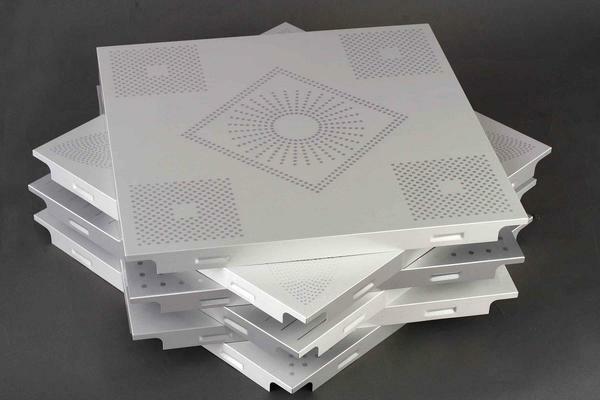 Polyfoam tiles have a risk of yellowing under the influence of sunlight
Polyfoam tiles have a risk of yellowing under the influence of sunlight
All the disadvantages of foam plates are more than offset by pluses: cheap and lightweight polystyrene tiles will hide minor flaws in the ceiling, as well as decorate the room with proper approach to the choice of design and installation.
How to glue the ceiling with an
foam tile To glue the ceiling surface with foam plates, you first need to check the condition of the original ceiling surface. Remember that the slabs are really capable of hiding the small defects in the ceiling, but do not trust the foam plastic grooves and the influx of more than half a centimeter.
If your ceiling is relatively flat, clean and ready for pasting, then do the following:
- Mark the ceiling diagonally from corner to corner.
- Begin pasting from the center with a special solution on an adhesive basis.
- Press the plate against the flow with little effort, but so that the clutch is maximized.
- Each next plate must go as close as possible to the previous one;Avoid gaps.
- If desired, you can glue the ceiling skirting. This completes the picture.
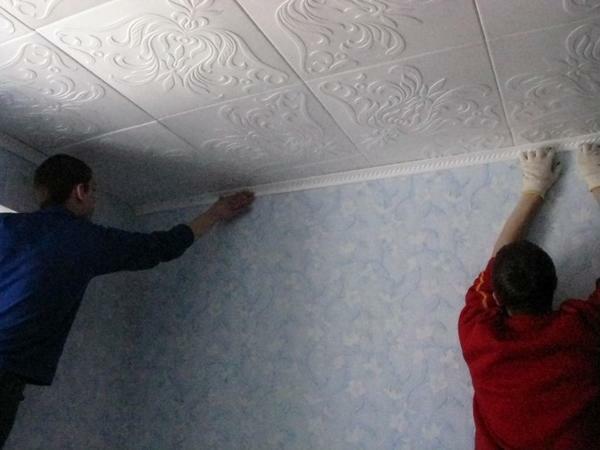 Foamed plastic foam can be glued to almost any surface
Foamed plastic foam can be glued to almost any surface
To create a feel of a relief or stretch ceiling, use a seamless tile of the highest quality materials.
Ceiling from foam plates:
operation features If you have already installed a ceiling made of foam plastic tiles, you may need help with some of the questions about using this ceiling. The fact is that often with a messy pasting one or more plates can leave their original place. In this case, you need to replace the tiles. If the fallen tile remains intact, you should only remove the remnants of the old glue and glue the part again. In the case of a fracture, the details will have to be found the same.
When buying a plate, be sure to calculate 5-10 pieces in case of damage to the plate. Perhaps in a few years you will not be able to find such a tile that you need.
 For renovation of the decor in the room, the ceiling of PVC-tiles can easily be repainted in a different color.
For renovation of the decor in the room, the ceiling of PVC-tiles can easily be repainted in a different color.
There is a way to minimize all possible risks and troubles associated with the foam plastic ceiling. In this way is painting the ceiling.
Which features should be considered if you decide to paint the ceiling of foam:
- When painting, it is best to use water-based paint.
- Painting will help to hide the seams of the ceiling slabs.
- Correctly selected paint will transform the foam beyond recognition.
- If the pattern on the plate is too embossed, then not only the roller, but also the brush should be used.
- Apply only on a clean, dry surface.
- The paint is applied more often in several layers after the previous one has dried completely.
Laying foam plastic tiles on ceiling( video)
The design of the room depends largely on how the ceiling looks. To make a beautiful surface for a small amount of money, you can glue neat plush plates, and to enhance the positive effect, use the paint. If you want to see the room cozy and well-groomed, then the ceiling tile will allow you to independently turn a boring ceiling into a pleasant surface for the eyes.


